Viola instrument information
The viola is a bowed string instrument. It is the middle voice of the violin family, between the upper lines played by the violin and the lower lines played by the cello. You can think of it as the tenor voice in a string quartet with the first and second violins taking up the role of the soprano and alto and the cello taking the role of bass.
The casual observer may mistake the viola for the violin because of their similarity shape, closeness in pitch range (the viola is a perfect fifth below the violin), and identical playing position. However, the viola’s timbre sets it apart: its rich, dark-toned sonority is more full-bodied than the violin’s. The viola’s mellow voice is frequently used for playing inner harmonies, and it does not enjoy the wide solo repertoire or fame of the violin.
Its name is most commonly pronounce as “vee-oh-la”
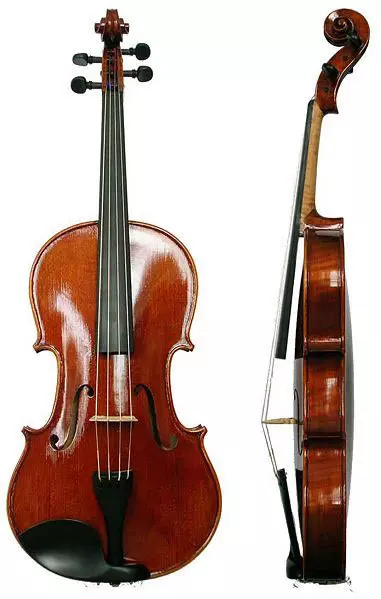
The viola is similar in material and construction to the violin but is larger in length and is deeper through the ribs. It can also be more variable in its proportions. On average, the “full size” viola’s body length is between one and four inches greater than the body of the full size violin. Viola sizes are measured in inches or in centimeters, with an average size of about 16 inches. Small violas made for children can be found as small as 11 inches, which is the same length as a quarter size violin. A fractional sized violin can be strung with viola strings (C, G, D and A) for children who need even smaller sizes. Unlike the violin, there is no standard “full size” viola. The player tends to have the largest instrument that they can manage. This depends on the height, arm-span and the size of the hands.
Acoustically the body of a viola would need to measure around 21 inches to match the acoustics of a violin. This large size would make it impractical to play in the same manner as the violin. For centuries violists have experimented with the size and shape of the viola, with viola makers often compensating by tweaking the proportions or shape of the instrument in order to make a viola with a shorter string length and lighter weight which still has a large enough sound box to create the unmistakeable “viola sound.”
In the beginning, notable experiments with the size of the viola tended to address the instrument’s sound by making it larger. These include Hermann Ritter’s viola alta, an instrument measuring about 18.9 inches intended for use in Richard Wagner’s operas. The Tertis model viola, which has wider bouts and deeper ribs to promote a better viola tone, is another slightly ‘non-standard’ shape which allows the player to use a larger instrument than normal. Many experiments with the acoustics of a viola, particularly increasing the size of the body, result in a much deeper tone of the instrument, making the instrument resemble the tone of a cello. Since many composers wrote for a more traditional sized viola, changes in the tone of a viola, particularly in orchestral music, can have unintended consequences on the balance in ensembles.
More recent (and more radically shaped) innovations address the ergonomic problems of playing the viola by making it shorter and lighter while finding ways to keep the traditional sound. These include Otto Erdesz ‘cutaway’ viola (which has one shoulder cut out to make shifting easier); the “Oak Leaf” viola (which has two “extra” bouts); viol shaped violas such as Joseph Curtin’s “Evia” model (which also utilizes a moveable neck and maple veneered carbon fiber back reduce weight); violas played as if they were cellos (see vertical viola); and the quite eye-catching “Dalí-esque” shapes of both Bernard Sabatier’s violas in fractional sizes (which appear to have melted) and of David Rivinus’ “Pellegrina” model violas (see External links).
Otto Erdesz “cutaway” Viola
Other experiments besides those dealing with the ‘ergonomics vs. sound’ problem have appeared. American composer Harry Partch fitted a viola with a cello neck to allow intonation with his 43-tone scale. Recently, several luthiers created five-stringed violas, which allow a greater playing range. Modern music is played on these instruments, but viol music can be played as well.
A person who plays the viola is called a violist or simply a viola player. While it is similar to the violin, the technique required for playing viola has many important differences, even though bowings, for example, are named the same, and dynamic markings look the same on paper. The most notable of these spring from the size of the viola, making it more physically demanding to play than the smaller, lighter violin. (There is anecdotal evidence that violinists who play the viola for a few months or more return to the violin as improved players).
Compared to a violin, the viola will generally has a longer body as well as a longer string length. The most immediately noticeable adjustments a player accustomed to playing violin has to make are to use wider-spaced fingerings, to use a wider and more intense vibrato in the left hand, and to hold the bow and right arm farther away from the player’s body. The player must also bring the left elbow farther forward or around, so as to reach the lowest string. This allows the fingers to be firm and create a clearer tone. Unless the violist is gifted with especially large hands, different fingerings are often used, including frequent use of half position and shifting position, where on the violin staying in one place would suffice.
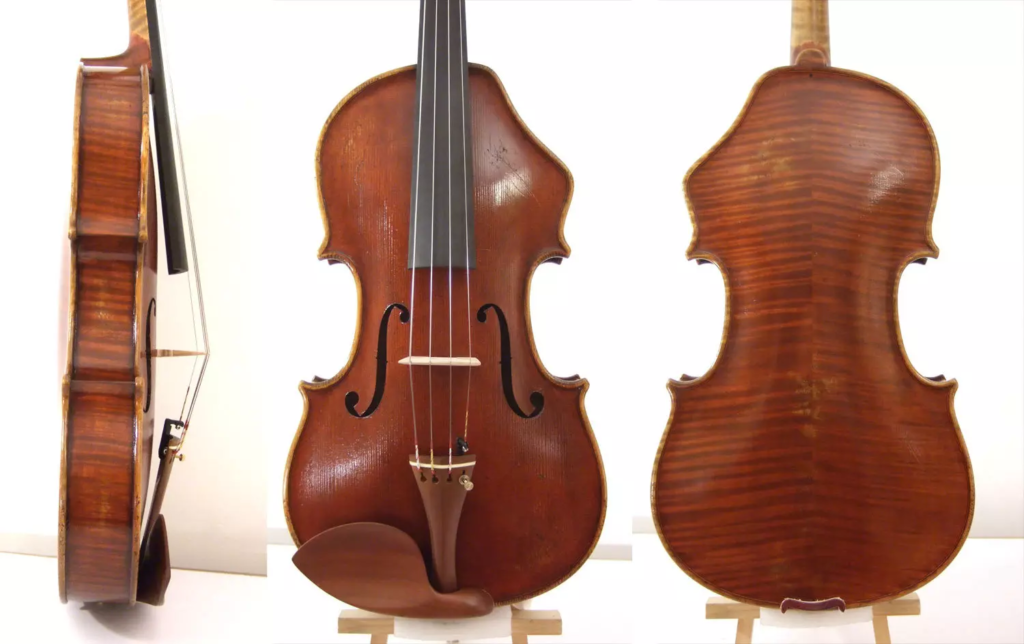
Compared to a violin, the viola will generally has a longer body as well as a longer string length. The most immediately noticeable adjustments a player accustomed to playing violin has to make are to use wider-spaced fingerings, to use a wider and more intense vibrato in the left hand, and to hold the bow and right arm farther away from the player’s body. The player must also bring the left elbow farther forward or around, so as to reach the lowest string. This allows the fingers to be firm and create a clearer tone. Unless the violist is gifted with especially large hands, different fingerings are often used, including frequent use of half position and shifting position, where on the violin staying in one place would suffice.
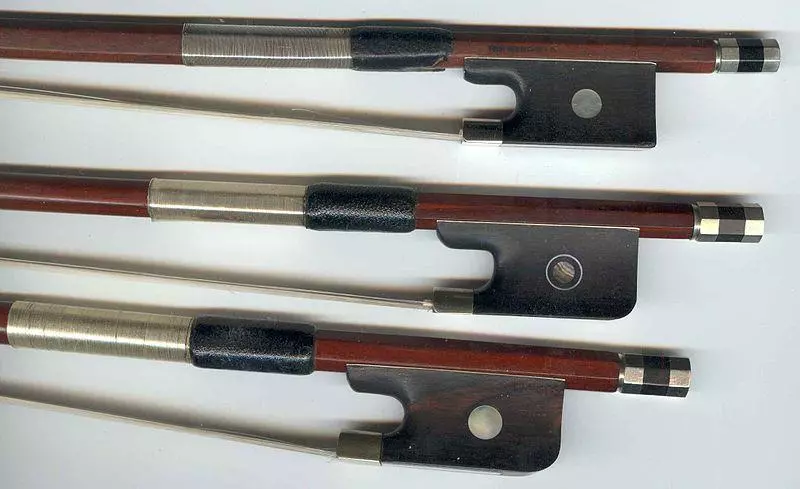
Bow frogs, top to bottom: violin, viola, cello.
The viola bow is the longest bow in an orchestra, with a wider band of horse-hair, particularly noticeable near the frog (or ‘heel’ in the UK). Viola bows (70 to 74 g) are heavier than violin bows (58 to 61 g). Bowing technique differs from violin bowing in that more weight must be applied to pull sound from the strings.
The viola’s four strings are tuned in fifths: the C an octave below middle C is the lowest, with G, D and A above it. This tuning is exactly one fifth below the violin, so that they have three strings in common—G, D, and A—and is one octave above the cello. Although the violin and viola have three strings tuned the same, the tone quality or sound color is markedly different.
Violas are tuned by turning the pegs near the scroll, around which the strings are wrapped. Tightening the string will raise the note (make it sharper) while loosening the string will lower the note (making it flatter). The A string is tuned first, typically to 440 Hz (see pitch). The other strings are then tuned to it in intervals of perfect fifths, bowing two strings simultaneously, or using a tuner, or the method often used in symphony orchestras: comparing the sound to instruments/violas that have been tuned (a piano can also be used). Most violas also have adjusters (also called fine tuners) that are used to make finer changes. These permit the tension of the string to be adjusted by rotating a small knob at the opposite end of the string, at the tailpiece. Such tuning is generally easier to learn than using the pegs, and adjusters are usually recommended for younger players, although they are usually used in conjunction with one another. Adjusters work best, and are most useful, on higher tension metal strings. It is common to use one on the A string even if the others are not equipped with them. Some violists reverse the stringing of the C and G pegs, so the thicker C string does not turn so severe an angle over the nut, although this is uncommon.
Small, temporary tuning adjustments can also be made by stretching a string with the hand. A string may be tuned down by pulling it above the fingerboard, or tuned up by pressing the part of the string in the pegbox. These techniques may be useful in performance, reducing the ill effects of an out-of-tune string until the arrival of a rest or other opportunity to tune properly.
The tuning C-G-D-A is used for the great majority of all viola music. However, other tunings are occasionally employed both in classical music (where the technique is known as scordatura) and in some folk styles. Mozart, in his Sinfonia Concertante for Violin, Viola and Orchestra, which is in E flat, wrote the viola part in D major and specified that the viola strings were to be raised in pitch by a semitone; his intention was probably to give the viola a brighter tone to avoid its being overpowered by the rest of the ensemble. Lionel Tertis, in his transcription of the Elgar cello concerto, wrote the slow movement with the C string tuned down to B flat, enabling the viola to play one passage an octave lower. Occasionally the C string may also be tuned up to D.
Historically, the viola was used less often for solo concerti and sonatas than the violin and the cello. This was often attributed to its sound, which, being mellower and perhaps less sharp than that of the violin, was said to be less suited to virtuoso display
Music is written for the violin in the alto clef. Viola sheet music also employs the treble clef during sections of the music written for the highest positions.
In early orchestral music, the viola part was frequently limited to the filling in of harmonies with little melodic material assigned to it. When the viola was given melodic parts in music of that era, it was often duplication in unison or octaves of whatever other strings played. A notable exception would be J.S. Bach’s Brandenburg Concerto No. 6, which placed the two violas in the primary melodic role (it was scored for 2 violas, cello, 2 violas de gamba, and continuo).
The viola plays an important role in chamber music. Mozart succeeded in liberating the viola somewhat when he wrote his six string quintets, which are widely considered to include some of his greatest works. The quintets use two violas, which frees the instrument (especially the first viola) for solo passages and increases the variety and richness of the ensemble. Mozart also wrote for the viola in his Sinfonia concertante in which of the two soloists, the viola is equally as important as the violin.
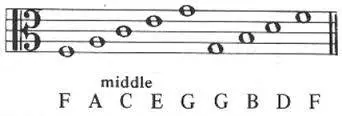
The tenor clef
Telemann’s viola concerto in G minor is considered to be one of the earliest compositions featuring the viola player as soloist. It forms part of the core repertoire for the violist.
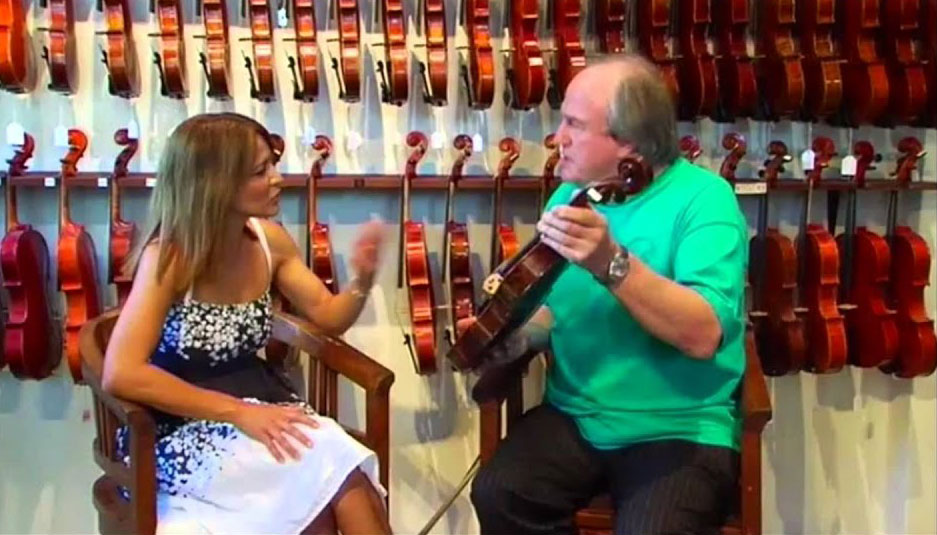
From his earliest works Johannes Brahms wrote music that features the viola prominently. His first published piece of chamber music, the sextet for strings op.18 contains what amounts to a solo part for the first viola. Late in life he wrote two greatly admired sonatas for clarinet and piano, his Opus 120 (1894); later Brahms transcribed these works for the viola. Brahms also wrote Two Songs for Alto with Viola and Piano (Zwei Gesänge für eine Altstimme mit Bratsche und Pianoforte), Op. 91, “Gestillte Sehnsucht” or “Satisfied Longing” and “Geistliches Wiegenlied” or “Spiritual Lullaby,” which was a present for the famous violinist Joseph Joachim and his wife, Amalie. Antonín Dvořák played the viola, and apparently said it was his favorite instrument; his chamber music is rich with important parts for the viola. Another Czech composer, Bedřich Smetana, included a significant viola part in his quartet “From My Life”; the quartet begins with an impassioned statement by the viola.
Amongst works written specifically for viola, the Stamitz and Hoffmeister viola concerti are two of the most important audition pieces. Max Bruch’s Romance in F Major is a work from the romantic era that viola players and their audiences will enjoy.
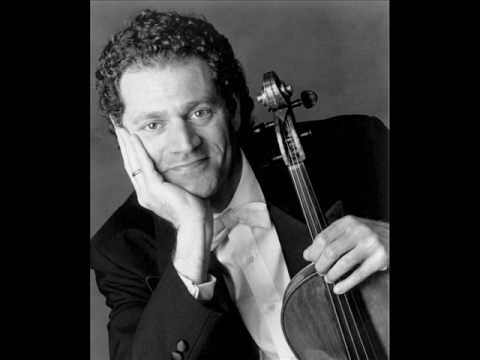
There are also more recent contributions to the viola repertoire that are worth exploring. The viola player Rebecca Clarke composed for the viola including this beautiful sonata for viola and piano.
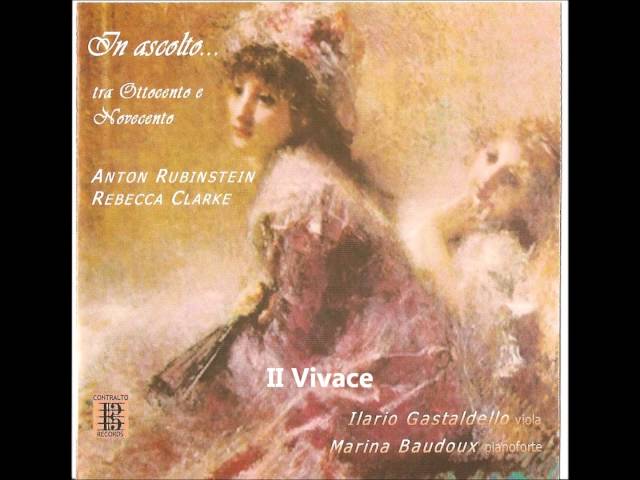
This page references Wikipedia, the online free encyclopedia. For more detailed information about the Viola you can refer to http://en.wikipedia.org/wiki/Viola
